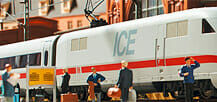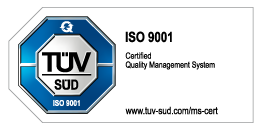Steam Locomotive, Road Number 18 201| Art.Nr.38201
The big surprise model
It is truly an almost unbelievable story that led to the building of one of the most elegant and powerful German steam locomotives. Road number 18 201 is the 180 km/h / 112 mph racer, which steamed for the first time on May 31, 1961, out of the venerable halls of the Meiningen maintenance and repair facility.
This locomotive was a child of the brilliant steam locomotive engineer Max Baumberg, who was the director after World War II of the Vehicle and Experimentation Institute (FVA) in Halle, Germany. Baumberg had a weakness for large, powerful express locomotives. As early as 1948 he had acquired the Baden class IVh, road number 18 314, from the West, which was later known as "Jorsch". After 1952 the four-cylinder locomotives built in France, road numbers 07 1001, 08 1001, and 79 001 came under Baumberg's wing. At that time, the terms "Baumberg's Zoo" or "Baumberg's Locomotive Circus" became established among railroaders.
At the end of the Fifties, the French locomotives had long since left Baumberg's menagerie and he was thus looking for a new circus star able to haul new passenger cars planned for export in experimental runs with speeds up to 160 km/h / 100 mph.
The only German State Railroad locomotive capable of this speed was road number 61 002 from the former Henschel-Wegmann train. With its own running gear, a part of the frame and with components of the unsuccessful H 45 024 high-pressure locomotive, Baumberg designed a highly modern Pacific locomotive with a tender (4-6-2 wheel arrangement). The standard design 39E rebuild boiler was used as a steam generator.
Check with your local dealer
Gauge H0 Era VI Locomotives
The new road number 18 201 was unusual in every respect: It had almost immense 2.30 meter / 89-11/16" high driving wheels, three cylinders, and they produced an impressive 2,150 horsepower. The pointed smoke box doors reminded people of the Bavarian S 3/6, the smoke deflectors and the streamlined areas were similar to the French class 232-U-1 super steam locomotive.
The new road number 18 201 was stationed at the Halle P Maintenance Facility, where the "Jorsch" was also at home. It was soon evident that road number 18 201 was a really big success. Baumberg could be proud of his racer, which reached a speed of 182.4 km/h / 114 mph on October 12, 1972. This made this elegant, green painted unit the fastest operational steam locomotive in the world.
Starting in 1980, "Jimmo", as road number 18 201 was now known, was used almost exclusively for special runs. A suitable auxiliary tender was built in the mid-Eighties to allow added supplies of water and oil on longer runs without the need for stops. This auxiliary tender was visually adapted to the locomotive.
In 1985, "Jimmo" was then allowed for the first time in the West – to the big railroad anniversary in Nürnberg. Two years later this racer was a star guest at the full railroad anniversary in Austria. After the reunification of West and East Germany, "Jimmo" could be experienced until 1997 on numerous special runs, and then the DB decided finally to take it out of service.
The well-known musician Axel Zwingenberger and the entrepreneur Andreas Goldschagg were finally able to convince the DB Museum to entrust them with "Jimmo". They had Baumberg's super locomotive overhauled, founded the firm DampfPlus (Steam Plus) and used road number 18 201 starting in 2002 to haul special trains all over Germany and in neighboring countries.
This second, very successful career finally ended on September 1, 2018, when the locomotive set off shortly before the expiration of the maintenance deadlines on a widely acclaimed special departure run.
Prototype: Express steam locomotive, road number 18 201, with oil main firing and an auxiliary tender. Former locomotive of the German State Railroad of the GDR (DR/GDR), which was built as an experimental locomotive of the VES-M Halle, Germany (Saale) (Railroad Research and Development Locomotive Management Department) from parts of road numbers 61 002 and H45 024. The locomotive looks as it did around 2017, as it was used pulling special trains.
Model: The locomotive has an mfx+ digital decoder and extensive light and sound functions. It also has controlled high-efficiency propulsion with a flywheel in the boiler. 3 axles powered. Traction tires. The locomotive and tender are constructed mostly of metal. There is a factory-installed smoke generator in the locomotive. It has dynamic smoke exhaust that varies with the locomotive speed and is digitally controlled. The triple headlights change over with the direction of travel, will work in conventional operation, and can be controlled digitally. There are also dual red lamps on the front of the locomotive, which can be controlled digitally. The cab lighting and the running gear lights can be controlled separately in digital operation. Maintenance-free warm white and red LEDs are used for the lighting. There is an adjustable close coupling with a guide mechanism between the locomotive and tender. There is a close coupler with an NEM pocket and a current-conducting guide mechanism on the tender for controlling headlights and marker lights on the auxiliary tender. The buffer height on the locomotive and tender adhere to the NEM. The auxiliary tender has operating, current-conducting close couplers at both ends. The lighting at the end of the tender can be selected by using a toggle switch on the floor of the tender. This lighting can be controlled digitally using the decoder for the locomotive. The minimum radius for operation is 360 mm / 14-3/16". Streamlining without wheel cutouts below the cab is included for installation for large radius curves or display cases. Piston rod protection sleeves and heating and brake hoses are also included.
Total length over the buffers approximately 40.8 cm / 16-1/16".
Highlights:
- Completely new tooling.
- Especially intricate metal construction.
- A variety of separately applied details.
- Factory-installed smoke unit and dynamic smoke exhaust that varies with the locomotive speed included.
- Cab lighting and the running gear lights can be controlled separately in digital operation.
- Operating, current-conducting close couplers on the tender and auxiliary tender included.
- World of Operation mfx+ decoder and extensive light and sound functions included.
- Buffer height on the locomotive and tender adheres to the NEM.
This model can be found in a DC version in the Trix H0 assortment under item number 25020.















